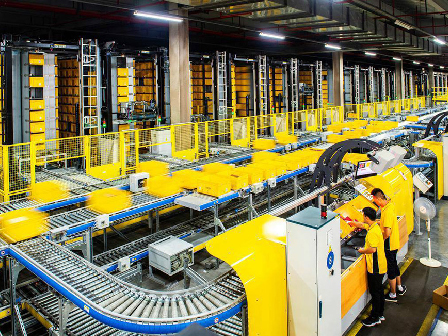The ball screw is a precision mechanical transmission element.
The following is a detailed introduction to it:
I. Definition and function
A ball screw is a device that converts rotary motion into linear motion or linear motion into rotary motion. It is mainly composed of a screw (or lead screw), a nut, and a ball. When the screw rotates, the nut moves along the helix of the screw, thereby achieving linear motion. The rolling of the ball between the screw and the nut effectively reduces friction and wear, and improves transmission efficiency and precision.
II. Working principle
The working principle of the ball screw is to use the rolling contact of the ball between the screw and the nut to transmit motion and power. When the motor or other power source provides rotary motion, the rotary motion is transmitted to the screw after passing through the reduction device. Since there are helical lines on the surface of the screw and the nut, when the screw rotates, the nut moves along the helix, thereby achieving linear motion. The rolling of the ball between the screw and the nut not only reduces friction and wear, but also improves transmission efficiency and precision.
III. Structural composition
A ball screw usually consists of the following components:
1. Screw: a shaft with a spiral groove, usually made of high-precision steel.
2. Nut: a component that cooperates with the screw, with a ball circulation channel inside.
3. Ball: rolling between the screw and the nut to achieve low-friction transmission.
4. Dust cover (or dust protector): prevents dust and debris from entering the interior of the ball screw and prolongs its service life.
In addition, some ball screws may also include components such as pre-loaded sheets and reversers to improve their rigidity and stability.
IV. Performance characteristics
1. High precision: The ball screw reduces friction and wear and improves transmission accuracy through the rolling contact of the balls. This makes the ball screw perform well in situations where high-precision positioning and motion control are required.
2. High efficiency: The rolling friction of the ball screw is much smaller than the sliding friction, so its transmission efficiency is as high as 90% or more. This can significantly reduce energy loss and improve system efficiency.
3. High rigidity: The ball screw has high rigidity and can withstand large loads. This makes it suitable for heavy-duty and high-precision applications.
4. Long life: The rolling contact mode of the ball screw reduces wear and extends the service life. With proper lubrication and maintenance, the ball screw can maintain good performance for a long time.
5. Low noise: The rolling contact mode of the ball screw reduces friction, so the noise is low during operation. This makes it suitable for occasions with strict noise requirements.
6. High response speed: The low friction characteristics of the ball screw give it a high response speed and can start and stop quickly. This is suitable for high-speed movement occasions.
V. Application fields
Due to its excellent performance, ball screws are widely used in various industrial equipment and precision instruments. Including but not limited to the following fields:
1. Industrial automation: such as automated production lines, robots, CNC machine tools, etc., which require high-precision and high-efficiency transmission.
2. Precision instruments: such as microscopes, measuring equipment, optical instruments, etc., which require extremely high transmission accuracy.
3. Medical equipment: such as surgical robots, medical imaging equipment, etc., which require high-precision and low-noise transmission.
4. Aerospace: fields with extremely high requirements for reliability and precision, such as satellites and aircraft.
5. Semiconductor manufacturing: such as wafer handling equipment, photolithography machines, etc., require high-precision and high-cleanliness transmission.
6. Automobile manufacturing: such as automobile assembly lines, testing equipment, etc., require efficient and stable transmission systems.
VI. Selection and maintenance
When selecting, the appropriate ball screw specifications should be selected according to the specific needs of the equipment. This includes factors such as transmission accuracy, load capacity, speed range, working environment, and installation size. At the same time, parameters such as the lubrication method and preload of the ball screw also need to be considered.
In terms of maintenance, the wear and lubrication status of the ball screw should be checked regularly to ensure its normal operation. Keep the ball screw clean to avoid dust and impurities. Add or replace lubricants regularly according to the use of the equipment. In addition, it is also necessary to pay attention to whether the fixing device of the ball screw is stable and whether preload adjustment is required.
In summary, the ball screw is a mechanical transmission element with high precision, high efficiency, long life and low noise. It plays an important role in various industrial equipment and precision instruments, providing reliable solutions for modern industrial automation and precision machinery.


 English
English Russian
Russian Spanish
Spanish Italian
Italian Arabic
Arabic Korean
Korean German
German Japanese
Japanese Vietnamese
Vietnamese Turkish
Turkish


